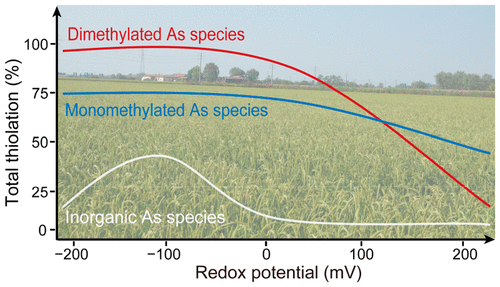当前位置:
X-MOL 学术
›
Environ. Sci. Technol.
›
论文详情
Our official English website, www.x-mol.net, welcomes your
feedback! (Note: you will need to create a separate account there.)
Redox Dependence of Thioarsenate Occurrence in Paddy Soils and the Rice Rhizosphere.
Environmental Science & Technology ( IF 10.8 ) Pub Date : 2020-03-23 , DOI: 10.1021/acs.est.9b05639 Jiajia Wang 1 , Dipti Halder 1 , Laura Wegner 1 , Lena Brüggenwirth 1 , Jörg Schaller 1, 2 , Maria Martin 3 , Daniel Said-Pullicino 3 , Marco Romani 4 , Britta Planer-Friedrich 1
Environmental Science & Technology ( IF 10.8 ) Pub Date : 2020-03-23 , DOI: 10.1021/acs.est.9b05639 Jiajia Wang 1 , Dipti Halder 1 , Laura Wegner 1 , Lena Brüggenwirth 1 , Jörg Schaller 1, 2 , Maria Martin 3 , Daniel Said-Pullicino 3 , Marco Romani 4 , Britta Planer-Friedrich 1
Affiliation

|
In flooded paddy soils, inorganic and methylated thioarsenates contribute substantially to arsenic speciation besides the much-better-investigated oxyarsenic species, and thioarsenate uptake into rice plants has recently been shown. To better understand their fate when soil redox conditions change, that is, from flooding to drainage to reflooding, batch incubations and unplanted microcosm experiments were conducted with two paddy soils covering redox potentials from EH −260 to +200 mV. Further, occurrence of thioarsenates in the oxygenated rice rhizosphere was investigated using planted rhizobox experiments. Soil flooding resulted in rapid formation of inorganic thioarsenates with a dominance of trithioarsenate. Maximum thiolation of inorganic oxyarsenic species was 57% at EH −130 mV and oxidation caused nearly complete dethiolation. Only monothioarsenate formed again upon reflooding and was the major inorganic thioarsenate detected in the rhizosphere. Maximum thiolation of mono- and dimethylated oxyarsenates was about 70% and 100%, respectively, below EH 0 mV. Dithiolated species dominated over monothiolated species below EH −100 mV. Among all thioarsenates, dimethylated monothioarsenate showed the least transformation upon prolonged oxidation. It also was the major thiolated arsenic species in the rhizosphere with concentrations comparable to its precursor dimethylated oxyarsenate, which is especially critical since dimethylated monothioarsenate is highly carcinogenic.
中文翻译:

水稻土和水稻根际中硫代砷酸盐的氧化还原依赖性。
在水淹的稻田土壤中,无机和甲基化硫代砷酸盐除了对氧砷的物种进行了更为深入的研究以外,还对砷的形态形成了重要贡献,最近已证明水稻植物中硫代砷酸盐的吸收。为了更好地了解它们在土壤氧化还原条件发生变化时的命运,即从洪水到排水再驱回,我们对两种稻田土壤进行了分批孵化和未种植的微观实验,覆盖了从E H -260到+200 mV的氧化还原电位。此外,使用种植的根瘤菌实验研究了氧化水稻根际中硫代砷酸盐的存在。土壤洪水导致无机硫代砷酸盐迅速形成,并以三硫代砷酸盐为主。无机含氧砷物质的最大硫醇化温度为EH -130 mV和氧化导致几乎完全脱硫。再驱时只有一硫代砷酸盐再次形成,是根际中检测到的主要无机硫代砷酸盐。在E H 0 mV以下,单和二甲基含氧砷酸盐的最大硫醇化分别约为70%和100%。在低于E H -100 mV的情况下,二硫代化合物占优势。在所有硫代砷酸酯中,二甲基化的单硫代砷酸酯在长时间氧化后显示出最少的转化。它也是根际中主要的硫醇化砷物质,其浓度可与其前体二甲基化的含氧砷酸盐相比,这是至关重要的,因为二甲基化的一硫代砷酸盐具有高度致癌性。
更新日期:2020-03-24
中文翻译:

水稻土和水稻根际中硫代砷酸盐的氧化还原依赖性。
在水淹的稻田土壤中,无机和甲基化硫代砷酸盐除了对氧砷的物种进行了更为深入的研究以外,还对砷的形态形成了重要贡献,最近已证明水稻植物中硫代砷酸盐的吸收。为了更好地了解它们在土壤氧化还原条件发生变化时的命运,即从洪水到排水再驱回,我们对两种稻田土壤进行了分批孵化和未种植的微观实验,覆盖了从E H -260到+200 mV的氧化还原电位。此外,使用种植的根瘤菌实验研究了氧化水稻根际中硫代砷酸盐的存在。土壤洪水导致无机硫代砷酸盐迅速形成,并以三硫代砷酸盐为主。无机含氧砷物质的最大硫醇化温度为EH -130 mV和氧化导致几乎完全脱硫。再驱时只有一硫代砷酸盐再次形成,是根际中检测到的主要无机硫代砷酸盐。在E H 0 mV以下,单和二甲基含氧砷酸盐的最大硫醇化分别约为70%和100%。在低于E H -100 mV的情况下,二硫代化合物占优势。在所有硫代砷酸酯中,二甲基化的单硫代砷酸酯在长时间氧化后显示出最少的转化。它也是根际中主要的硫醇化砷物质,其浓度可与其前体二甲基化的含氧砷酸盐相比,这是至关重要的,因为二甲基化的一硫代砷酸盐具有高度致癌性。











































 京公网安备 11010802027423号
京公网安备 11010802027423号